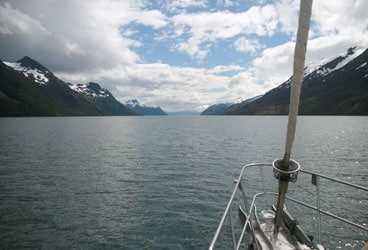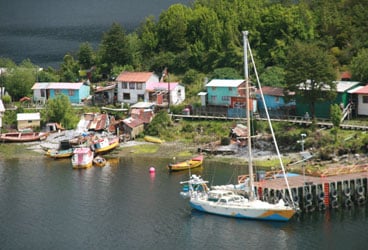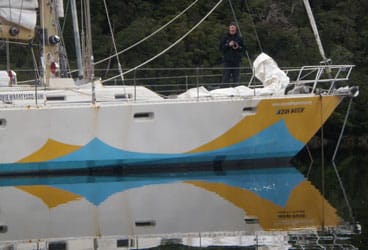
Beagle Canal 368
In the eight months since leaving Seattle, Washington, in June 2009, we’d seen just about every sort of weather imaginable: oppressive heat, numbing cold, fierce winds, flat calms, clear skies, and torrential rain. The only thing, really, that we hadn’t seen, was snow.
Shortly after rounding Cape Horn on our ongoing voyage Around the Americas (www.aroundtheamericas.org), we could check that one off the list, too.
We’d anchored for the evening in a rather exposed cove on the Chilean island of Isla Stewart, deep within southern Patagonia’s labyrinth of canals and glaciers. The anchor chain had rattled and clanged for much of the night, so we were anxious to get up and make tracks the next morning. But as I went forward to raise the ground tackle, I could barely believe my eyes. A dusting of snow was wafting from the heavens, and my seaboots left tracks on the foredeck.

Herb McCormick|
|The small Chilean fishing village of Quellon was the first town — and fuel stop — for Ocean Watch after a thousand miles exploring the wilds of Patagonia.|
Half an hour later, we were motoring west up a spectacular waterway called Canal Ballenero, flanked by tall peaks covered in fresh snow. The scenery was simply magnificent. It was hard to believe we’d almost missed it.
The original plan after transiting the Horn, however, had been to keep heading offshore to the west. But a series of strong gales were swooping in from that direction, so skipper Mark Schrader opted for Plan B: a return to Puerto Williams, followed by an express tour of the Patagonian channels en route to our next port of call, the far southern port of Puerto Montt.
So, just three days after we put Cape Horn astern, we pointed Ocean Watch into the Northwest Arm of the Canal Beagle, so named for the vessel aboard which a young Charles Darwin slipped through these very waters at the outset of his historic travels. The primary feature of this stretch of the Beagle is the Darwin Cordillera, a jaw-dropping range of nearly 8,000-foot mountains that’s chock-full of ventisqueros, or glaciers, like Italia, España, and the most famous of them all, the Romanche. We passed them, mostly, in awestruck silence.

Herb McCormick| |Ocean Watch photographer David Thoreson enjoys a reflective moment in a quiet Chilean anchorage.| On we went, though the Canal O’Brien, past Isla Stewart, and into the famous Strait of Magellan. For the most part, we kept pressing, trying to keep to a hectic schedule, but at times the powerful westerlies had their say in the matter, and on a couple of occasions we stayed put for a day or two in some protected anchorage to wait out the weather. It took us two tries to get past Isla Tamar, at the mouth of the Magellan, and through a nasty pass of open water called Paso Tamar. Then, after wending our way through another series of taut canals-Collingswood, Sarmiento, Inocentes, Concepcion, and Wide-we finally made it to our first settlement in many moons, the tiny outpost of Puerto Eden.
There were still 400 miles to go to Puerto Montt, and the unscheduled detour was costing us time. But from the snowy decks to the frosted summits, it’d certainly been worth it.








